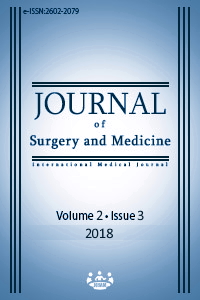The demographic and clinical characteristics of patients with cerebral palsy: A retrospective, single center, observational study
Keywords:
Cerebral palsy, Clinical characteristics, Magnetic resonance imagingAbstract
Aim: Cerebral palsy (CP) is a disorder of movement, muscle tone or posture that is caused by damage that occurs to the immature, developing brain, most often before birth.
A good definition of the disease will help for early diagnosis and treatment. The aim of this study was to evaluate the sociodemographic, clinical and radiologic characteristics of patients who were followed up as CP diagnosis.
Methods: Our study was designed as a retrospective, cross-sectional and descriptive. Forty-six patients with CP were included in the study. The age, sex, type of CP, accompanying clinical findings, presence of mental retardation, and cranial magnetic resonance imaging (MRI) data were recorded in the patient files.
Results: The types of CP were determined as spastic hemiparesis in 12 (26.1%) patients, spastic paraparesis in 9 (19.6%), spastic tetraparesis in 17 (37.0%, most frequently)), ataxic in 3 (6.5%), hypotonic in 1 (2.2%), extrapyramidal in 2 (4.4%) and mixed type in 2 (4.4%). In the MRI findings, arachnoid cyst was observed in 4 (11.4%) patients, basal ganglion intensity in 8 (20.2%), encephalomalacia in 8 (20.2%), frontogliotic area in 30 (80.7%, mostly frequently), cortical atrophy in 6 (17.1%), megacisterna in 5 (14.3%), and centrum semiovale hyperintensity in 8 (20.2%). Findings of hypoxic ischaemic brain injury were determined in 32 (91.4%) patients.
Conclusion: As CP is a group of diseases for which diagnosis may be difficult but early diagnosis can be beneficial, children at high-risk from birth must be closely monitored, the families must be warned, and if necessary early neuro-imaging tests should be requested. In the long-term follow-up process, in respect of both rehabilitation and the follow-up of comorbidities such as epilepsy, the treatment and follow-up of patients must be applied by a multidisciplinary team to be able to reach maximum physical capacity.
Downloads
References
Colver A, Fairhurst C, Pharoah PO. Cerebral palsy. Lancet. 2014;383(9924):1240-9. doi: 10.1016/S0140-6736(13)61835-8.
MacLennan AH, Thompson SC, Gecz J. Cerebral palsy: causes, pathways, and the role of genetic variants. Am Jour Obst Gynecol. 2015; 213(6):779-88.
Richards CL, Malouin F. Cerebral palsy: definition, assessment and rehabilitation. Handb Clin Neurol. 2013;111:183-95.
Graham HK, Rosenbaum P, Paneth N, Dan B, Lin JP, Damiano DL, et al. Cerebral palsy. Nat Rev Dis Primers. 2016;2:15082. doi: 10.1038/nrdp.2015.82.
Winter L, Colditz PB, Sanders MR, Boyd RN, Pritchard M, Gray PH, et al. Depression, posttraumatic stress and relationship distress in parents of very preterm infants. Arch Womens Ment Health. 2018 Mar 3. doi: 10.1007/s00737-018-0821-6.
Yöneyman F, Gürvit G, Yusuf M. Ro-CODEC Screening of the frequency of chronic diseases in children 1997;83-84.
Umphred DA. Neurological Rehabilitation. Mosby Inc. 2001;259-86.
Sigurdardottir S, Thorkelsson T, Halldorsdottir M, Thorarensen O, Vik T. Trends in prevalence and characteristics of cerebral palsy among Icelandic children born 1990 to 2003. Dev Med Child Neurol. 2009;51(5):356-63.
Pereira A, Lopes S, Magalhães P, Sampaio A, Chaleta E, Rosário P. How Executive Functions Are Evaluated in Children and Adolescents with Cerebral Palsy? A Systematic Review. Frontiers in Psychology. 2018;9:21.
O’Callaghan ME, MacLennan AH, Gibson CS, et al. Epidemiologic associations with cerebral palsy. Obstet Gynecol. 2011;118:576-82.
Oğuz H, Dursun E, Dursun N. Medical Rehabilitation. Istanbul, Nobel Medicine Publisher 2004;957-74.
Weir FW, Hatch JL, McRackan TR, Wallace SA, Meyer TA. Hearing loss in pediatric patients with cerebral palsy. Oto & Neur. 2018;39(1):59-64.
Yalçın S, Özaras N, Dormans J. Cerebral Palsy Treatment and Rehabilitation. Mas Printing. 2000;13-31:51-6.
Downs J, Blackmore AM, Epstein A, Skoss R, Langdon K, Jacoby P at al. The prevalence of mental health disorders and symptoms in children and adolescents with cerebral palsy: a systematic review and meta‐analysis. Develop Med & Child Neur. 2018;60(1):30-8.
Rosenbaum P, Paneth N, Leviton A, Goldstein M, Bax M, Damiano D at al. Dev Med Child Neurol Suppl. 2007;109:8-14.
Reid SM, Dagia CD, Ditchfield MR, Carlin JB, Reddihough DS. Population‐based studies of brain imaging patterns in cerebral palsy. Develop Med & Child Neur. 2014;56(3):222-32.
Piovesana AM, De Moura-Ribeiro MV, Zanardi VA, Gonçalves VM. Hemiparetic cerebral palsy etiological risk factors and neuroimaging. Arq Neuropsiquiatr 2001;59:29-34.
Downloads
- 1707 1863
Published
Issue
Section
How to Cite
License
Copyright (c) 2018 Yılmaz İnanç, Tuba Tülay Koca
This work is licensed under a Creative Commons Attribution-NonCommercial-NoDerivatives 4.0 International License.
















